RB Leipzig visited Köln at an empty RheinEnergieSTADION in what was a crucial game for the away side as they look to secure a top-four finish in the Bundesliga. The previous matchup between these two sides resulted in a dominant 4-1 win for Julian Nagelsmann’s side, which included a double from Emil Forsberg. Both Köln and Leipzig had dropped points in their previous matches against Hoffenheim and Hertha Berlin respectively.
This tactical analysis will examine the tactics used by both Köln and Leipzig in this Bundesliga match. The analysis will highlight both teams’ pressing, the success of Leipzig’s build-up play and who won the set-piece battle.
Lineups

Köln began with a 4-4-1-1 setup that they used for the majority of the fixture. Manager Markus Gisdol started a back four consisting of Benno Schmitz, Rafael Czichos, Toni Leistner and Noah Katterbach. The midfield line had two holding midfielders in Jonas Hector and Ellyes Skhiri with Ismail Jakobs and Florian Kainz acting as the wide midfielders. Jhon Córdoba, who is having his most prolific Bundesliga season yet, lead the line with Elvis Rexhbecaj playing a little bit deeper.
Leipzig manager Julian Nagelsmann organised his starting line-up in a typically flexible 4-4-2 formation with high defensive and pressing lines. Péter Gulácsi once again starts in goal with a familiar back four of Angeliño, Lukas Klostermann, Dayot Upamecano and Nordi Mukiele. Konrad Laimer and Marcel Sabitzer were the chosen double pivots with Dani Olmo and Christopher Nkunku as the wide playmakers. The complementary duo of Timo Werner and Patrik Schick completed the starting eleven as a front two.
Intense pressing on both sides
Both Köln and Leipzig are high pressing teams and in this fixture, this was very evident. The fact that they share this trait in their playing identity made the game very even throughout the game, which is shown by the fact that both teams had an equal share of the possession as neither team was proficient at breaking the press consistently. The intense press from both teams also meant that each team lost the ball frequently as their average possession duration was only 12 seconds. There were some key differences in how both teams pressed and we will look at Köln’s implementation of the high press first.
Gisdol’s side were highly impressive in the press this game, as they managed to have a PPDA of 9.1, which means they only allowed just over 9 passes per defensive actions. The numbers showcase that they increased their intensity ever so slightly in the second half, as their PPDA was at an incredibly low 7.2 – a value that surpasses the 11.9 they managed in the opening 45 minutes. The reason for this was twofold: firstly, they were chasing the game for the whole of the second half so they needed to counter-press even more for a better opportunity closer to goal; and Leipzig were able to find different solutions to bypass their press, which we will cover later.
The frame below highlights Köln’s structure and pressing in the mid-block. Köln started with a 4-4-1-1 but the centre-forward joined the striker in pressing the two Leipzig centre-backs, who are good at progressing the ball. The forwards are there to pressure the opposition defenders to shift the ball into the wider areas. Leipzig tend to have one of their double pivots drop deep so that they can still progress the ball vertically. Köln counteract this by placing a midfielder on the opposition midfielder, Hector on Sabitzer in this example, essentially rendering the opponent useless in the build-up. There are two banks of three with either the left or right full-back tasked to closing down the player who will receive the ball and in the case below, it is the left midfielder deputising as the left-back.
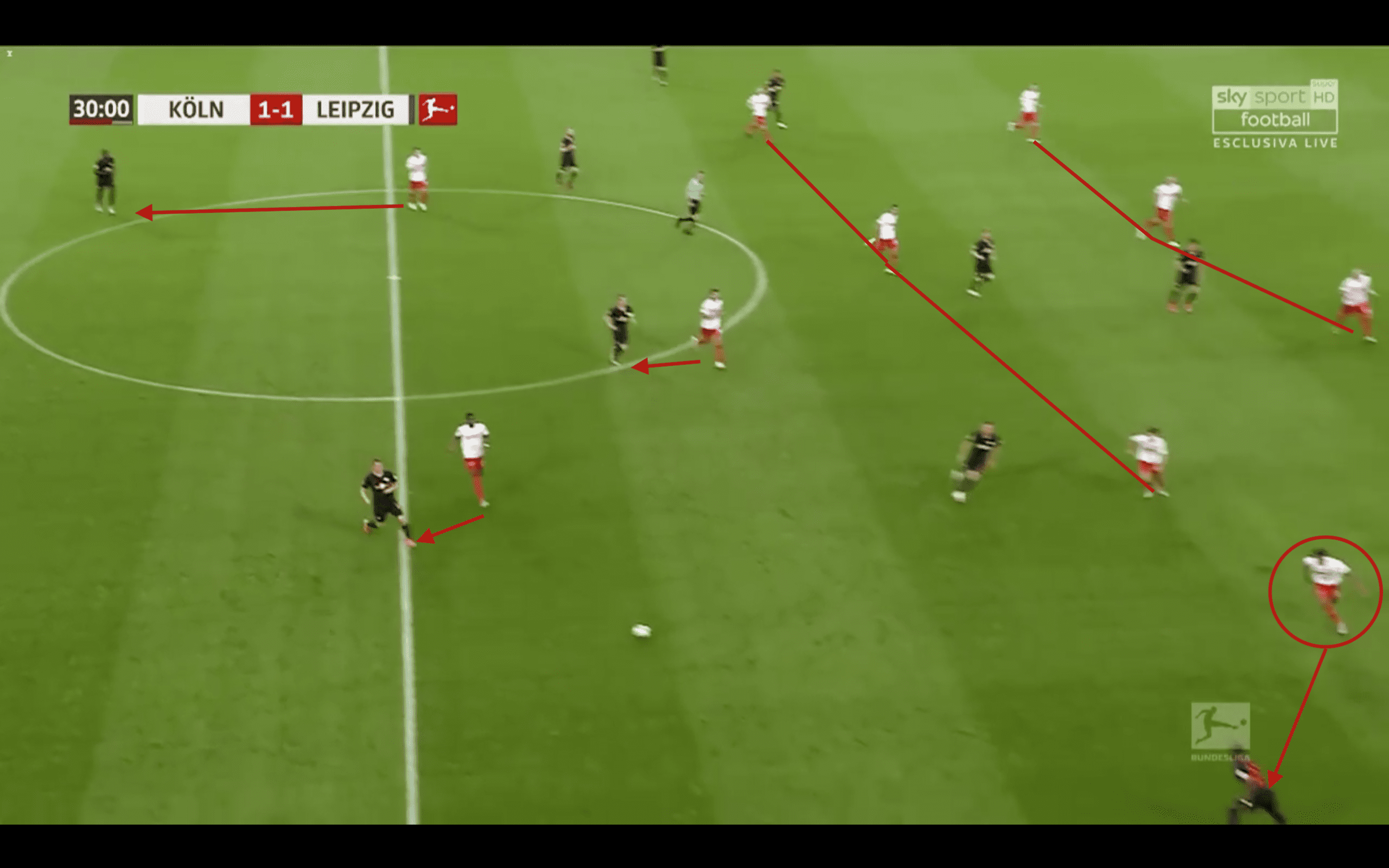
Throughout the game, this worked quite well as Leipzig struggled to create a lot of chances of note whilst in this position. However, this style required a lot of discipline positioning, which is difficult to maintain for a game. It also becomes difficult to achieve in transition, which is where Leipzig found some success.
To Köln’s credit, their pressing higher up the pitch with a similar foundation also worked well. In the example below, you can see the two forwards pressing the opposition keeper and defenders with Anthony Modeste, an early substitute to replace the injured Córdoba, pressing the keeper whilst cutting out the passing lane to Upamecano. Once again, Sabitzer drops deep to become a passing option but Hector follows him. Therefore, Gulácsi has no choice but to clear the ball and Gisdol’s team are able to recycle possession.
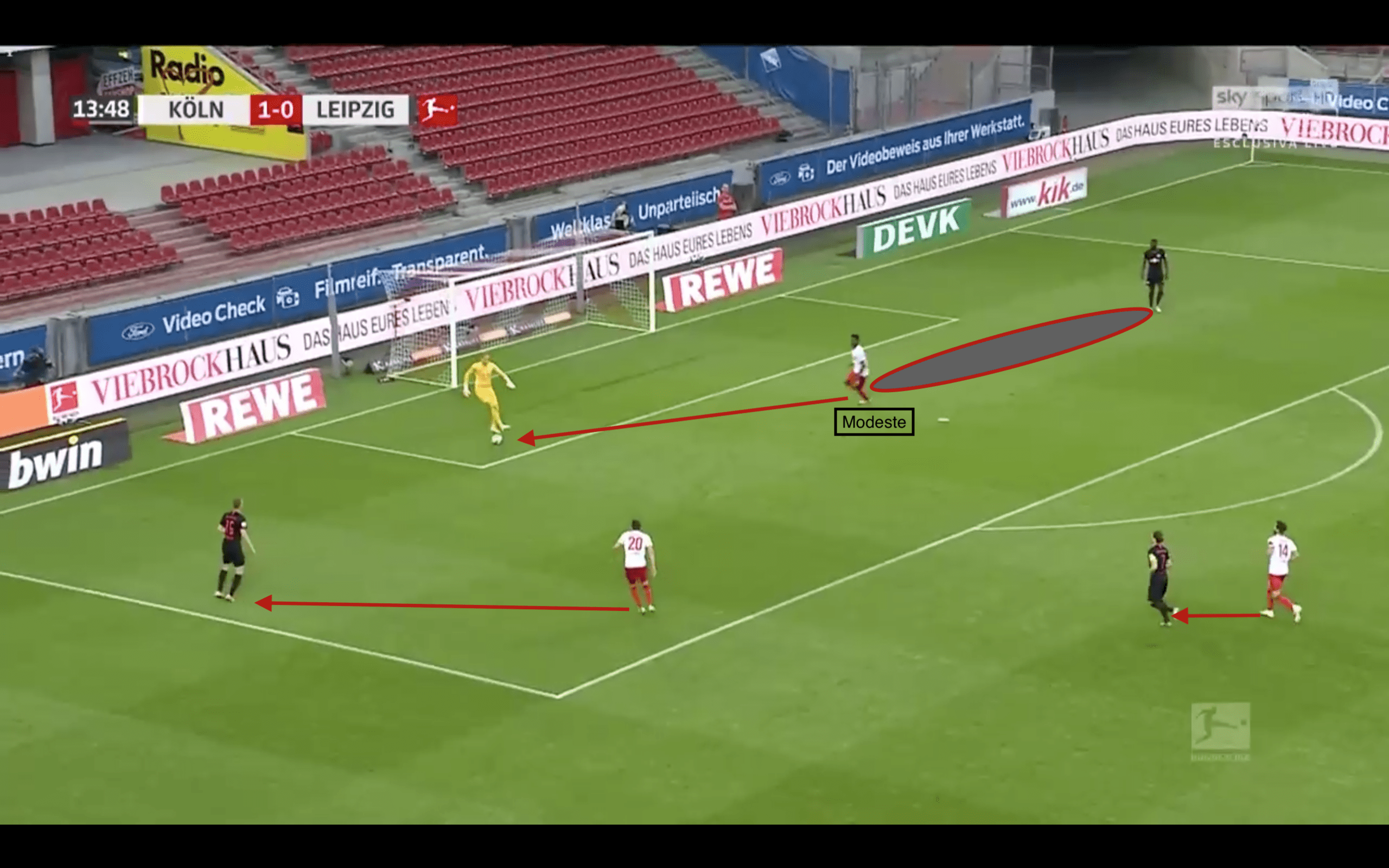
In the second half, they tried to keep the same structure but tried to force Leipzig into more mistakes especially in the middle of the park. In the image below, you can see that Köln needed a way back into the game and so instead of waiting for Leipzig to shift the ball wide, they doubled the midfielders who occupied the central area.
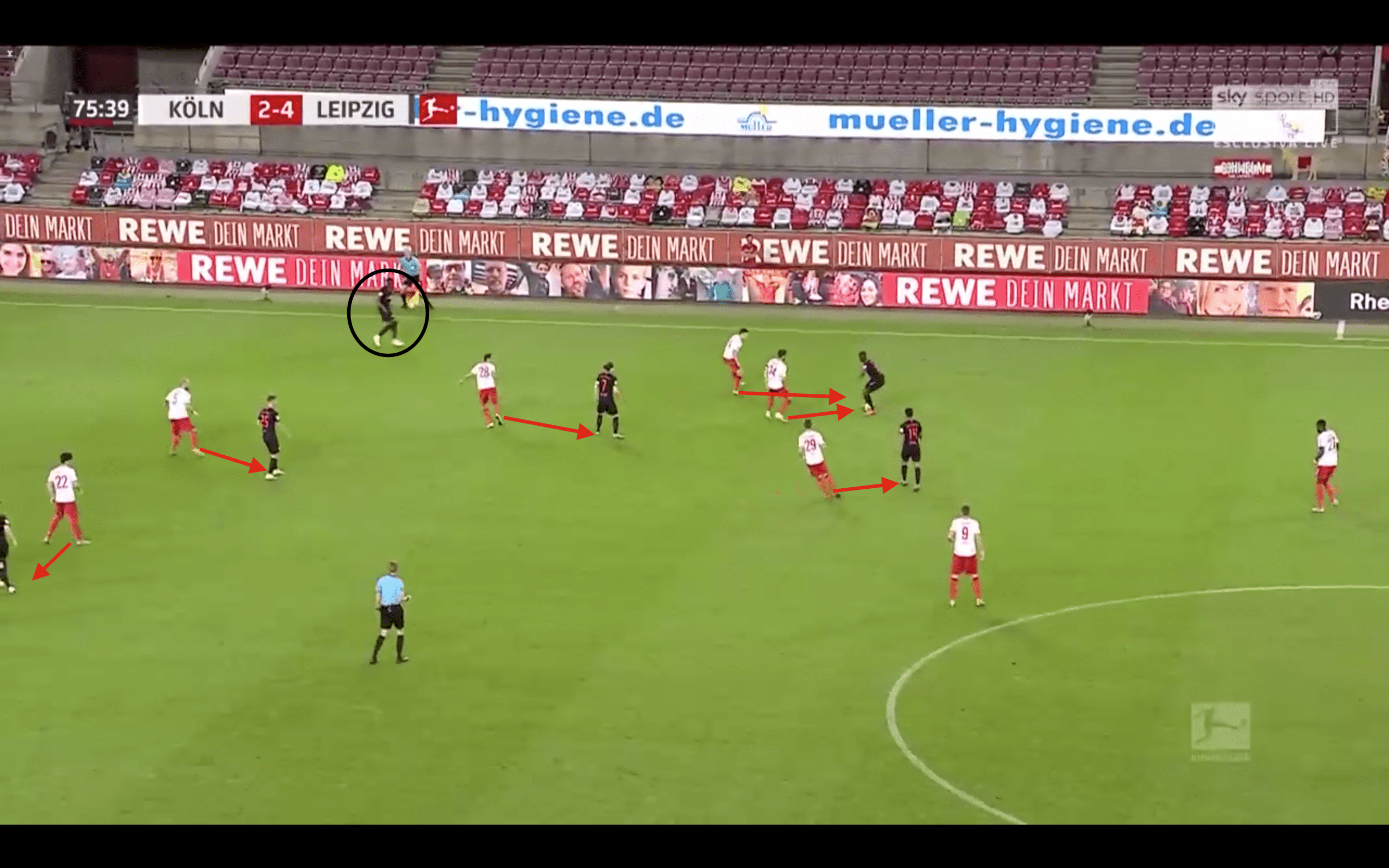
The arrows indicate that nearly every Leipzig player was marked with two players on the midfielder with the ball. The unmarked player is right-back Mukiele but the passing option to his cut-off well by the help midfielder pressing the player on the ball. In this scenario, Köln were unable to win the ball back immediately but it did force Leipzig to play the ball back to the defenders so that they can restart the build-up.
Leipzig had a similarly great press as their counterparts with a PPDA of 10.8 overall, with their pressing game the best in the first half as they only allowed Köln to have 9.4 passes per defensive action.
Nagelsmann’s team have a similar structure and press in the mid-block but there are some key differences, which can be seen below. Leipzig also have two forwards pressing the two opposition defenders but there is slightly less emphasis on winning the ball back upfront. This is because Köln often had a midfielder drop deeper to create a 3vs2 situation when building up from the back. While that allowed to move the ball higher up, there was now a numerical mismatch in the middle of the park, thus Leipzig let them progress past the attackers. Behind the forwards, there was two banks of four. Once the ball came into or in-between the two banks, the players would press man to man. The two double pivots, Laimer and Sabitzer, would do this for the majority as the wide midfielders were mainly tasked to close out the opposition wide players. If the ball was played into the middle and was close to the back four, the defenders would step up and press as the double pivots do in front of them. Once again, the full-backs main responsibility is to press the wide man, just like the wide playmakers in front of them.
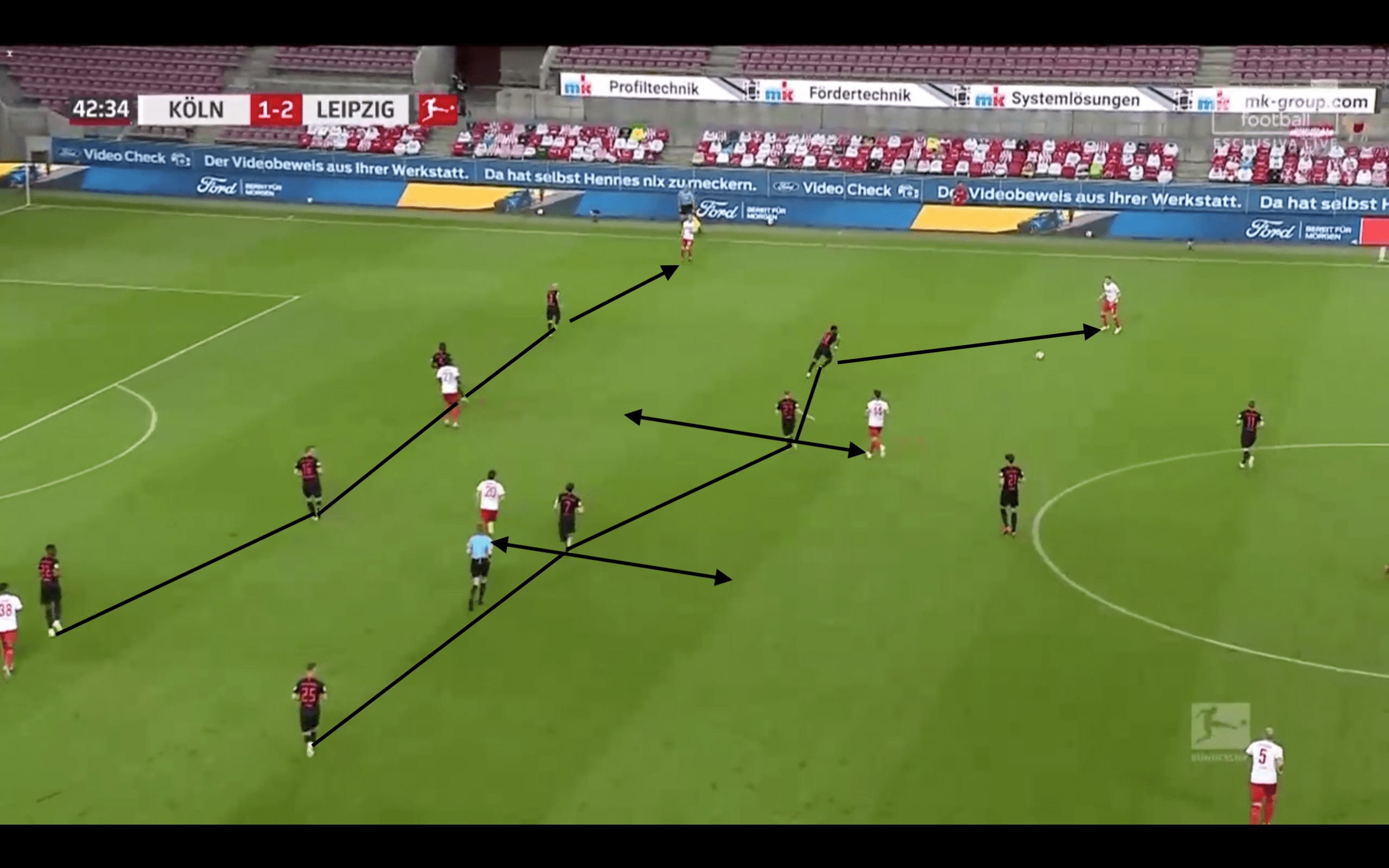
Köln struggled to get through this system as they lacked the vertical and penetrative passing and the double pivots did a great job of clogging up the midfield with their aggressive press. Despite having Córdoba and Modeste up top, Köln were outmatched aerially too with the presence of Upamecano and Klostermann.
When the Köln keeper Timo Horn had the ball, the Leipzig press was not as aggressive as their opposition was. This follows on from what was mentioned earlier in terms of how there was less of emphasis to win the ball back high and this can be seen below. Here, you can see the clear 3vs2 scenario with Nkunku too far out to make it a 3vs3 situation. Werner presses the defender and keeper but drops back after Horn has played the ball out wide. His strike partner Schick going out to press the player who will receive the ball. However, there is a huge space in the middle for an opposition midfielder, as Leipzig are hoping that Köln try to build-up centrally.
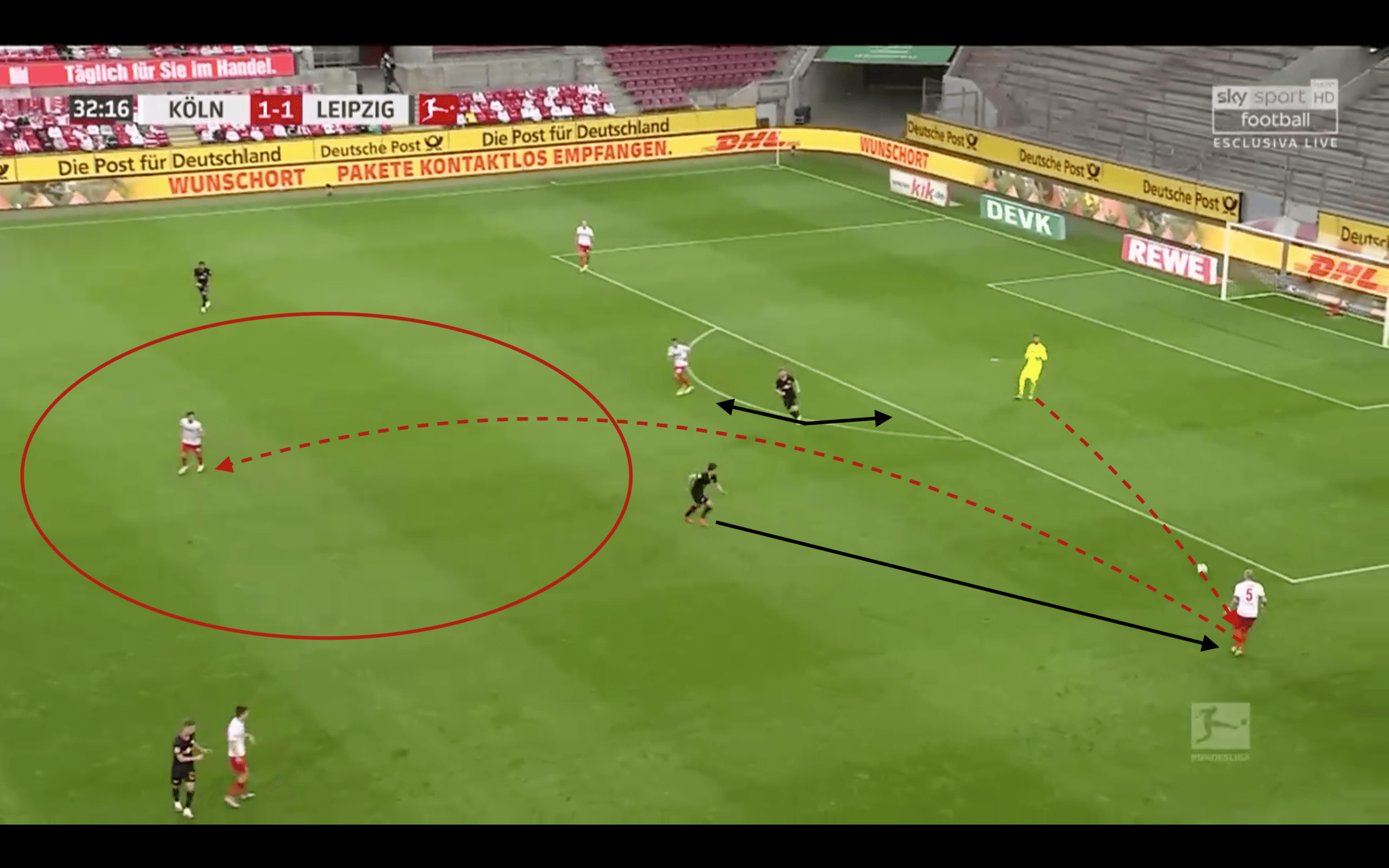
Leipzig’s build-up play
The criticism of Leipzig since the Bundesliga restart has been that they have not been clinical in front of goal despite their great build-up play. In this fixture, it was the opposite as Köln’s press and structure did a good job of preventing clear-cut chances for Leipzig. However, there were several ways that Nagelsmann’s team bypassed the press.
One of the staples in Nagelsmann’s teams week in week out are his double pivots and they played a key role in the build-up once again. The RB franchise teams, Leipzig, Salzburg and New York, all have an emphasis on building-up using verticality and Sabitzer and Laimer were key against Köln. Nagelsmann’s pivots are, for the most part, in the same plane and are often staggered to help the build-up.
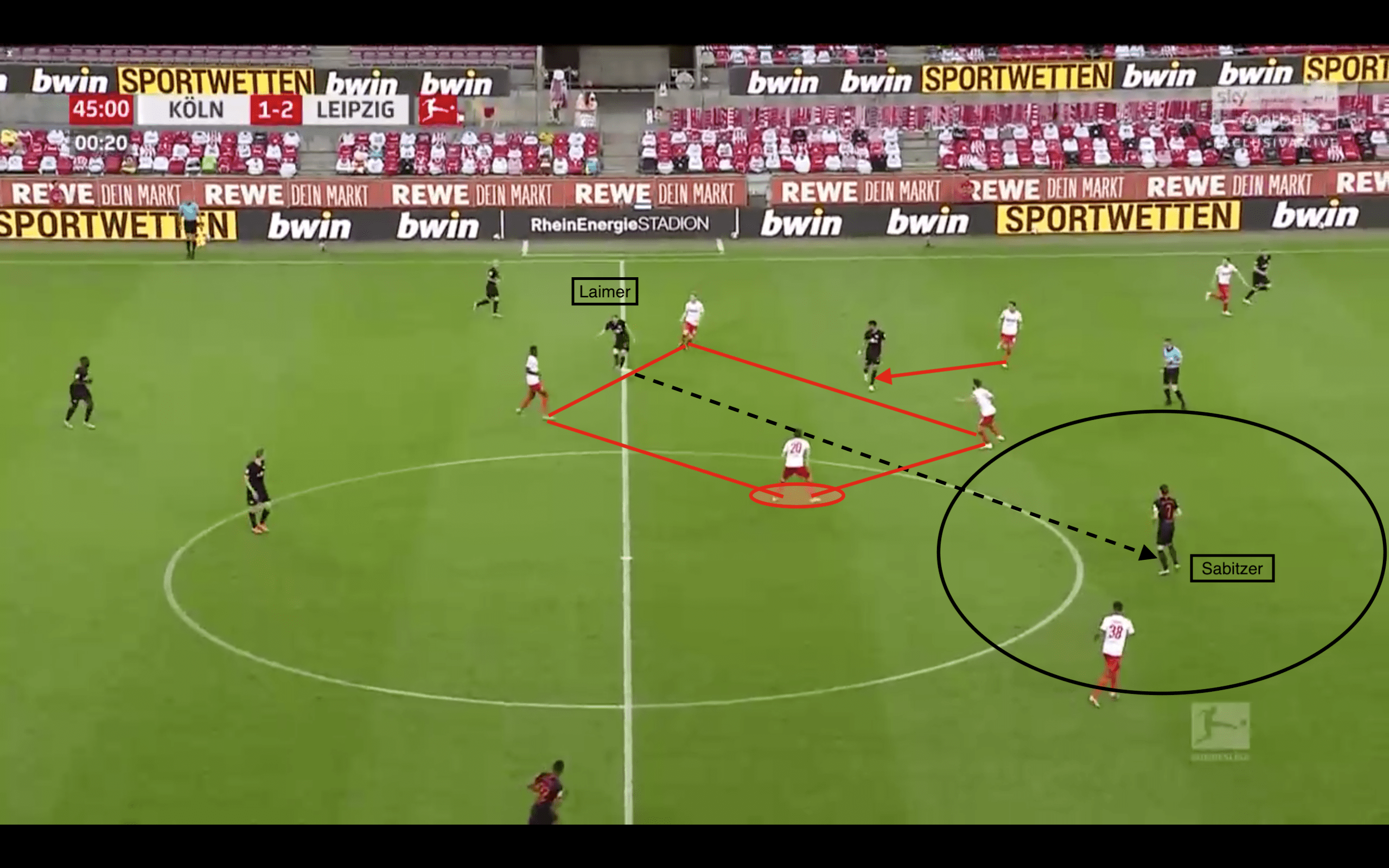
Above, you can see Laimer and Sabitzer are not in the same vertical plane, with Sabitzer stepping up higher without the knowledge of the highlighted Köln midfielder. The opposition midfielders create a box to try and make it more difficult for Laimer to find a way out and they also have Nkunku marked closely. However, Sabitzer’s great positioning means Laimer is able to take out four players with a driven diagonal pass and Leipzig are able to launch an attack. They play ends with a blocked shot that goes out for a corner but begins through an easy and repeatable exchange. Leipzig did this move several times, with either Laimer or Upamecano stepping up into the midfield and finding the open man.
Another crucial set-up for Nagelsmann is that he has one of the pivots move alongside a centre-back for an extra passing option from playing out from the back. In the example below, you can see this as Sabitzer receives a slightly diagonal pass from Klostermann, who is just behind the Austrian international.
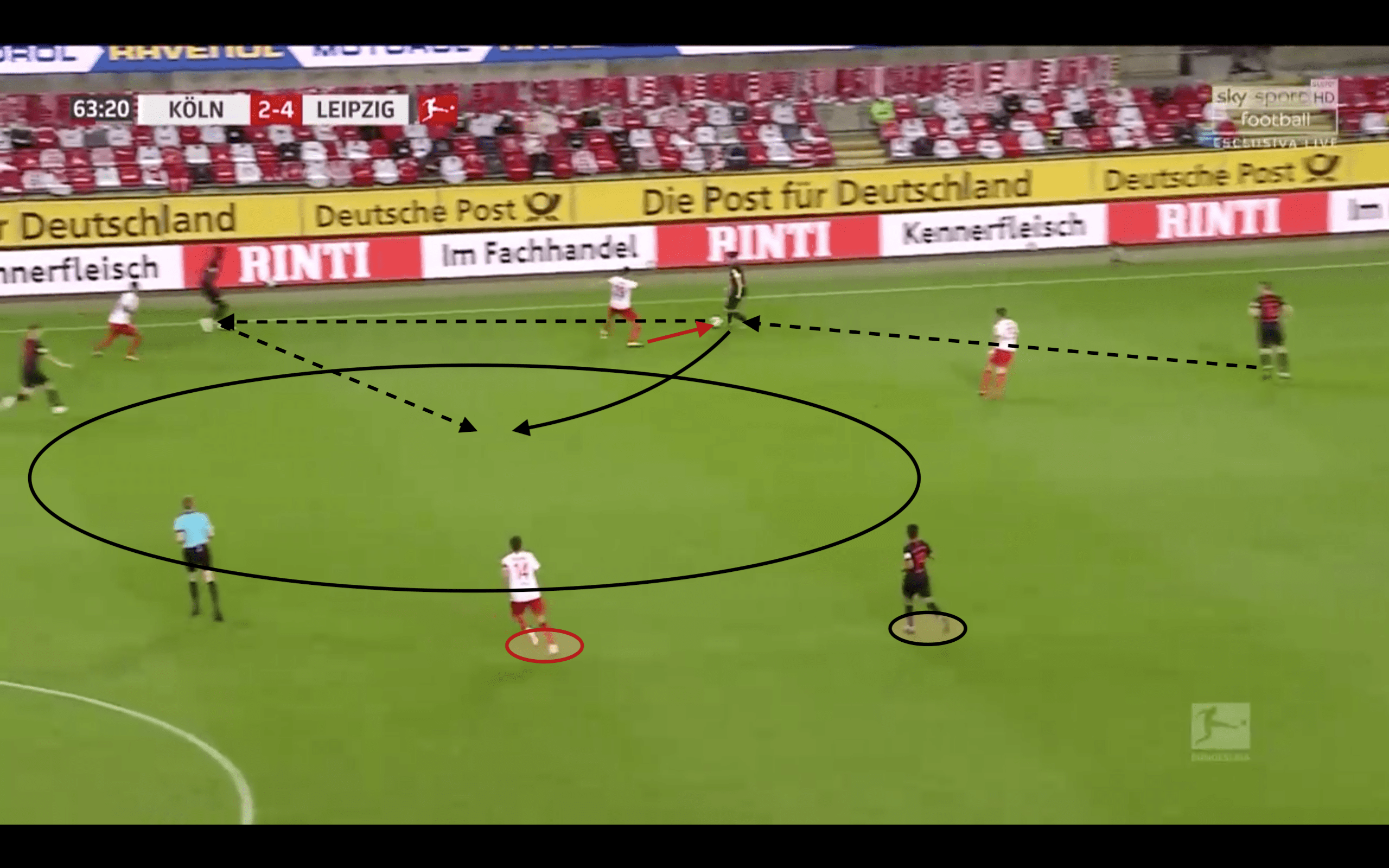
With Köln dedicated to the high press, especially when chasing the game, a midfielder follows Sabitzer leaving open space in the middle. A quick one-two with Mukiele allows Sabitzer to drive into space and further on. However, Hector, who is highlighted, recognises this and tries to press the midfielder. The German international thus leaves Tyler Adams, also highlighted, open and he receives the ball in a lot of open space. He decides to drive forward and play the ball onto the left-hand side where Leipzig end up having a penalty shout that was waved off.
To progress the ball vertically, Leipzig have a repeatable play to do this that can be called as the up-down-through method, where they play the ball up the pitch, lay the ball off to a teammate and proceed to play a pass in behind. The example below showcases a slight variation of this method.
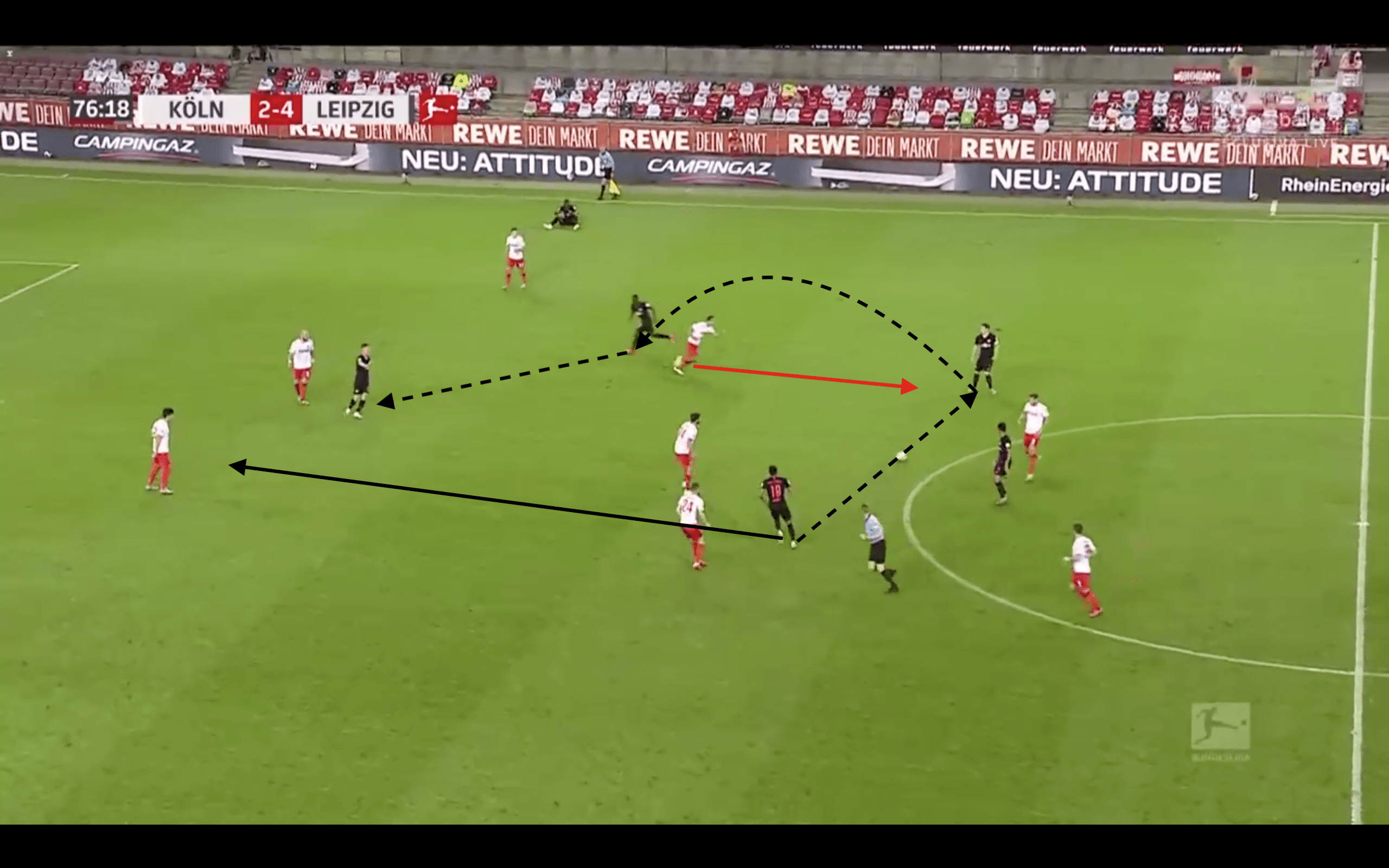
Once again, Sabitzer plays a key role in this play working. Nkunku plays a ball into his feet and with Köln desperate to win the ball back, a player tries to press him. Whilst this is happening, Haidara makes an excellent movement to occupy the space that the opposition midfielder has left behind. Sabitzer makes an easy pass into the Frenchman and with Nkunku making a bursting run forward, Leipzig have a 3vs2 scenario. The attack leads to a high-quality chance that was missed by Dani Olmo. This pattern of play was used several times despite Köln’s effective pressing and was even done in their penalty box, such is Leipzig’s confidence in their combination play.
Set-pieces win the game
Even though there were six goals on show in this game, most were due to moments of brilliance or great set piece work. This should come as no surprise as both teams not only press well, they are superb at taking advantage of set-plays with Köln and Leipzig the top two teams in set-piece goals this campaign. In this battle, Leipzig dominated the successes in set-pieces, most notably in corners. Nagelsmann’s team did score a counter-attacking goal from a Köln free-kick but their corner work was superb.
In the example below, Nkunku plays a corner short into Angeliño, who then proceeds to play a pass into Sabitzer.
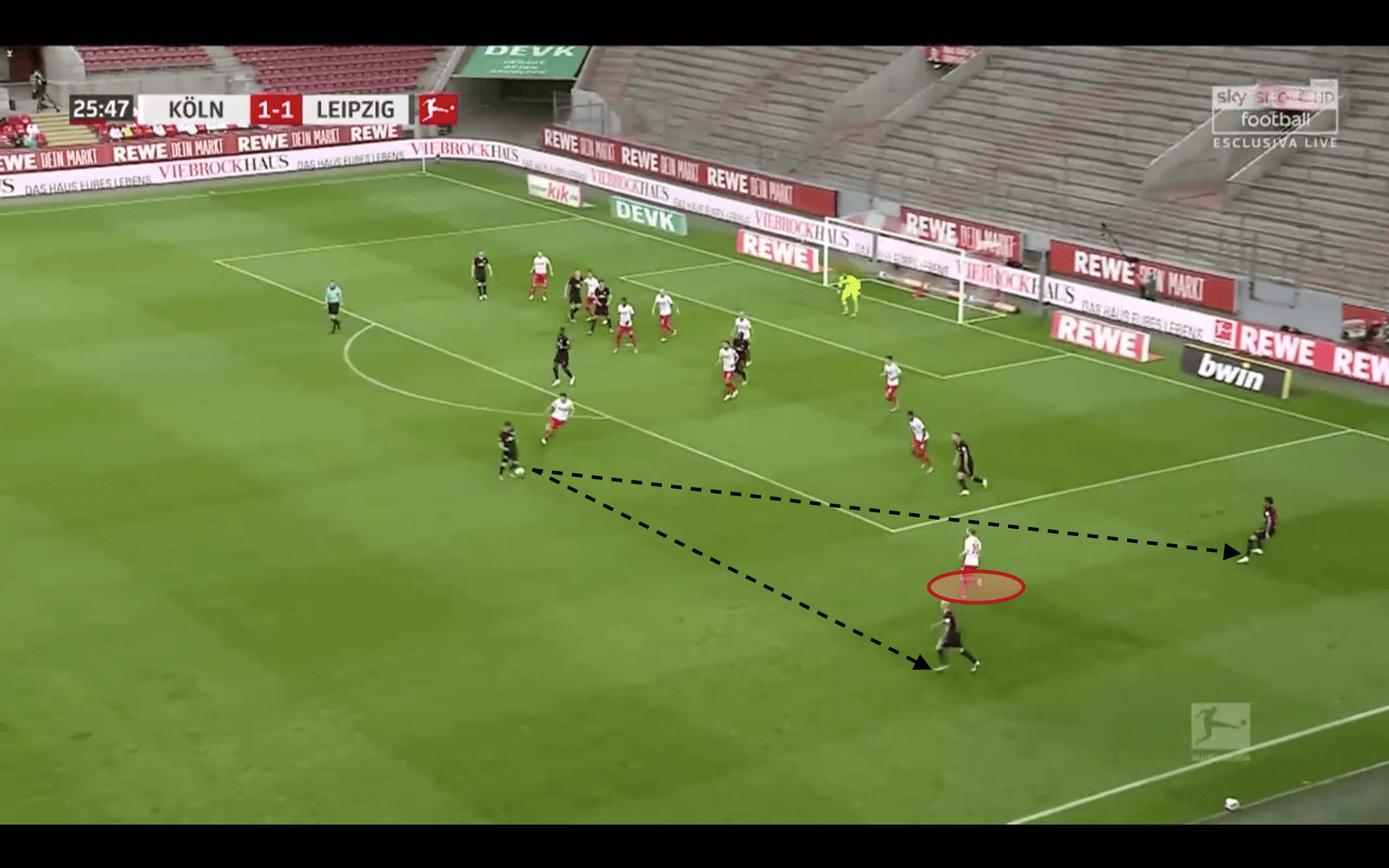
This is great work from Leipzig because Sabitzer has two completely open passing options available as the defender highlighted is caught in between the two open Leipzig players. He doesn’t have enough time to close down either player but drifts closer to Nkunku since the midfielder will have a better angle for the delivery. Therefore, the captain decides to play it to Manchester City loanee Angeliño.
Just before the delivery into the box, Olmo and Schick are looking for space in the box and take a play from basketball and put into action. Schick essentially screens the defender next to Olmo and the Spanish midfielder rolls around the screen in behind, which is called the pick and roll in basketball. Following the screen, Schick curls around the defender in front of him, whilst staying onside, in order to get in behind into space.
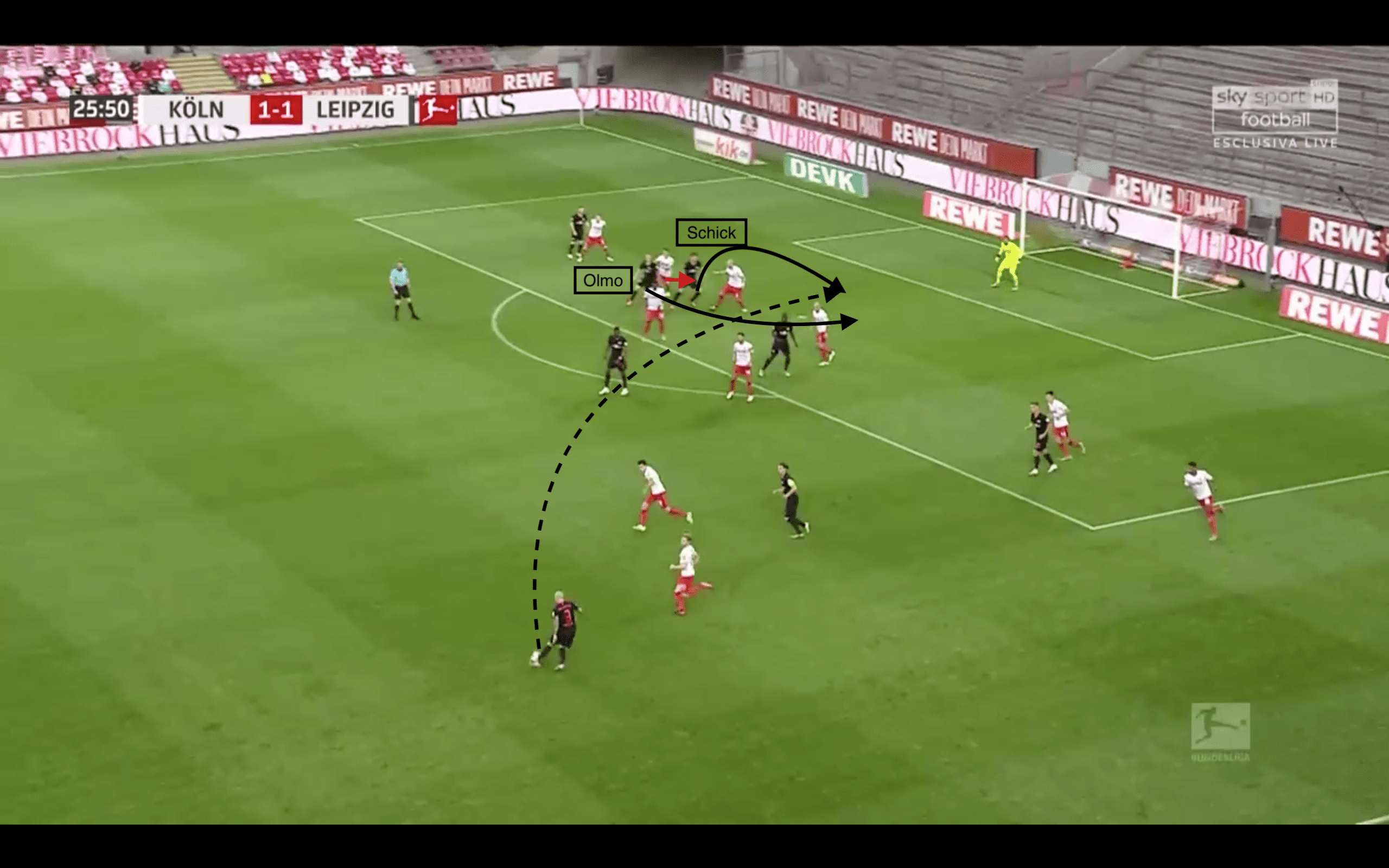
The Köln defence steps out, but Leipzig’s duo stay onside and once the ball comes in, are in free space to attack the ball. Schick manages to get a header on the ball but it just goes over the bar. For Gisdol’s team, they were just outdone by a great move in the box but the defender ahead of Schick was slightly flat-footed and was unable to track the run of the Roma loanee because of it.
Leipzig went onto score from a corner but it was a very simple corner that involved a little bit of fortune. Once again, Nkunku stepped up to take the corner but this time he delivered the ball into the box.
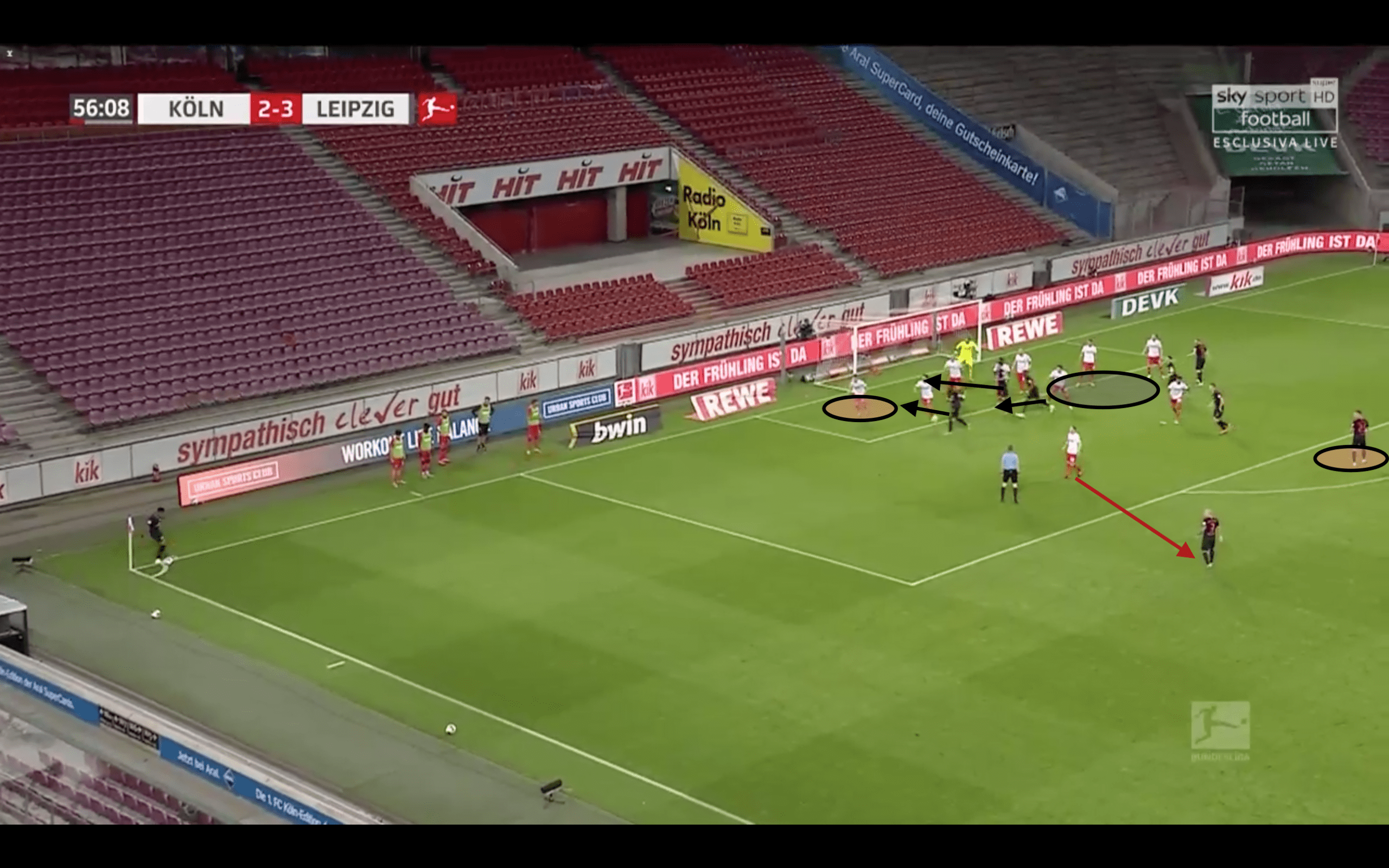
The Leipzig players run to overload the front post, to either win a header at the near post or to create space in the middle for a teammate to run in and head the ball if the cross goes beyond the near post. A Köln defender is aware of Angeliño and is close enough to close him down if the ball goes to him. Notice that Olmo is free on the edge of the area since Köln have opted to have a man covering the near post. However, every Köln player is in the box compared to just eight for Leipzig meaning that Olmo should ideally be marked.
In the end, this proves to be decisive as Modeste heads the ball out from Nkunku’s near post delivery but it lands straight at the Spaniard’s feet. As you can see below, Olmo has a lot of time and space to take a touch and strike the ball, which ends up going past Horn to make it 4-2 in Leipzig’s favour.
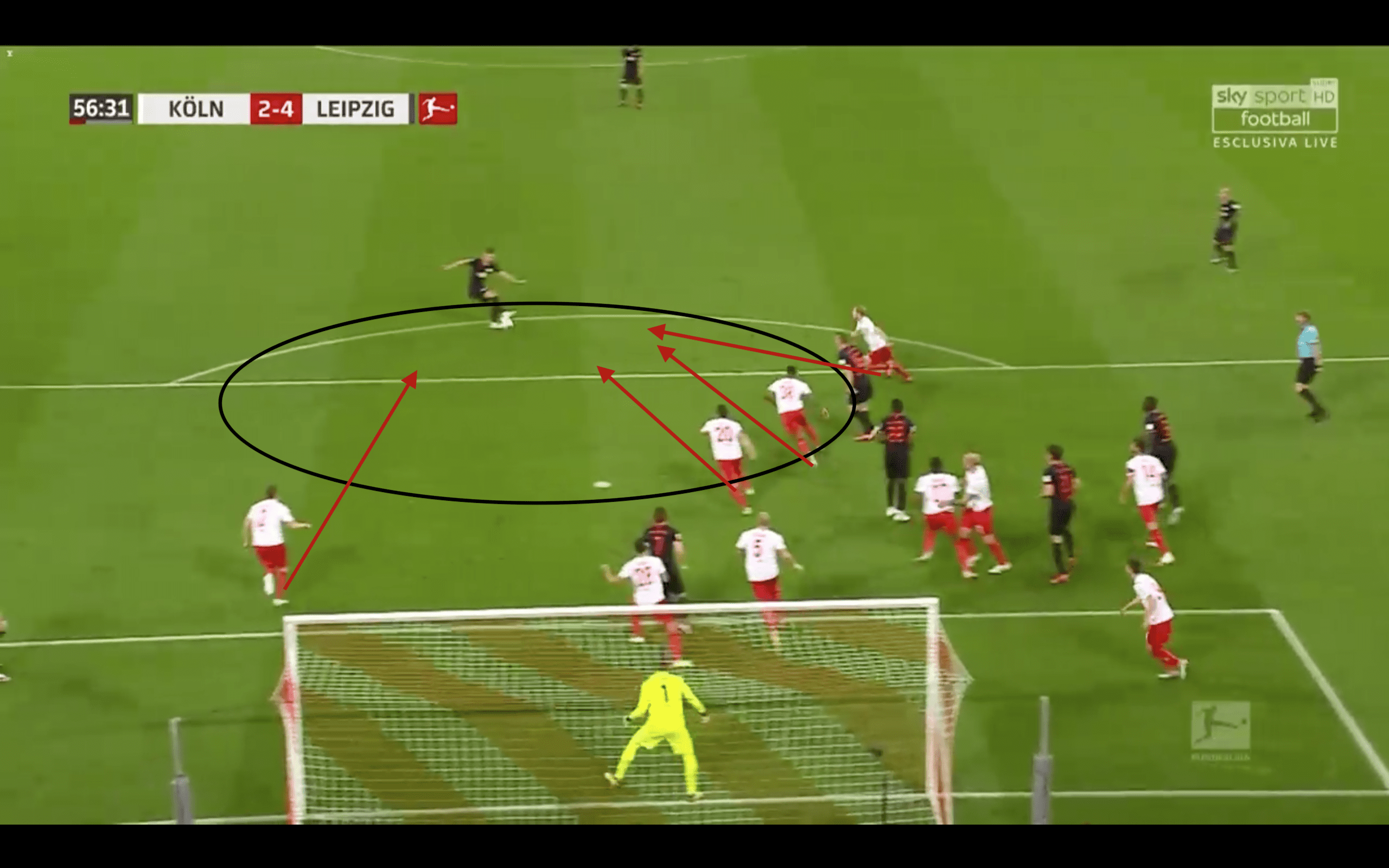
Köln’s second phase defending cannot be blamed considering the set-up did put them in this position. The fortune in this set-piece goal is in Modeste’s clearance landing straight to Olmo. However, Leipzig’s set-piece routines and defence against Köln were superb and yielded two goals, which is a great feat and speaks to Nagelsmann’s eye for detail and his players’ great execution.
Final remarks
The game ended in a 4-2 win for Leipzig and they move closer to securing their Champions League place for next season. The scoreline does flatter Nagelsmann’s team as Köln’s tactics were ultimately undone by great individual quality from Schick and the aforementioned set-piece execution. Leipzig are just two points away from second place Borussia Dortmund and welcome bottom of the league Paderborn next.
Gisdol’s side put up a good performance against a strong side especially considering that their talisman Córdoba had to be replaced just 24 minutes into the game. They are currently in 11th place and are set to stay in the Bundesliga for next season. They face relegation-threatened Augsburg away from home in their next fixture.





Comments